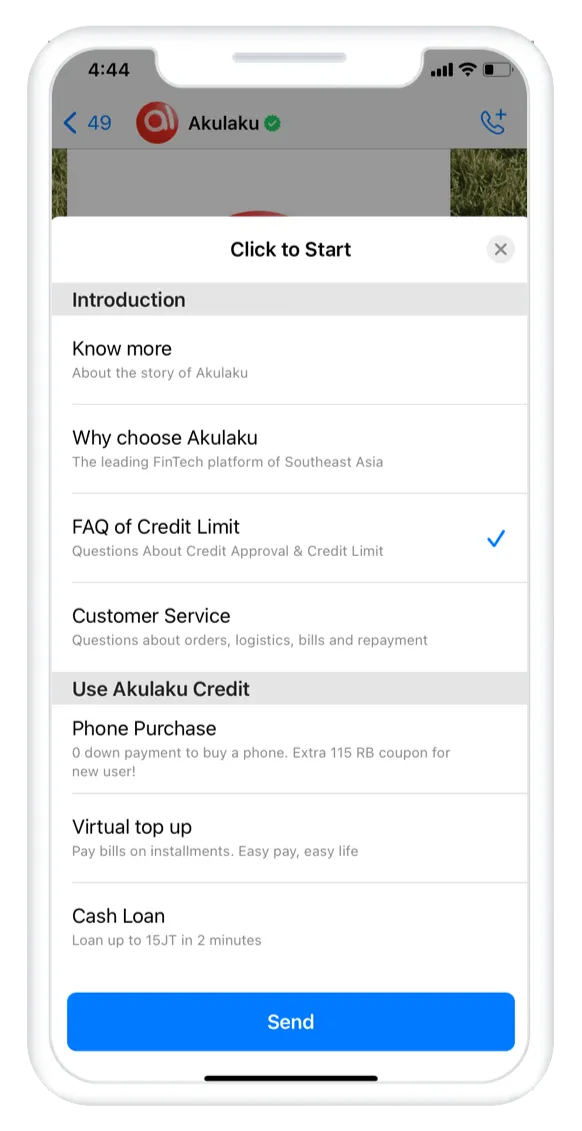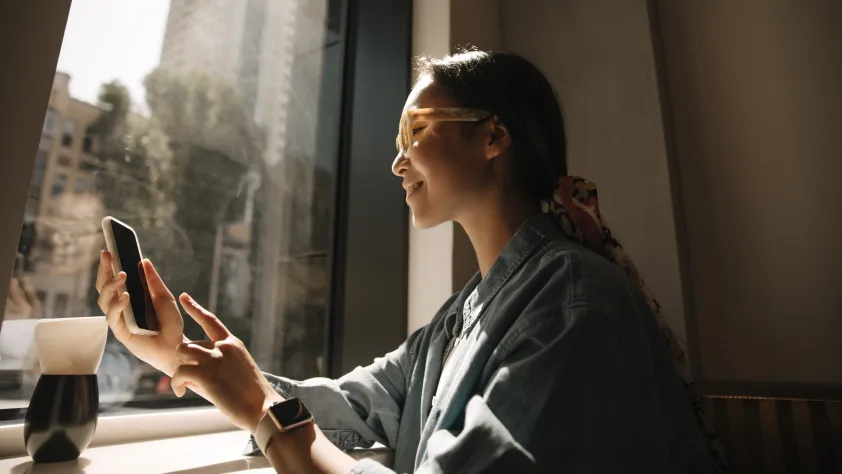
Customers
Leveling Up Customer Care through High-Impact Messaging
March 6, 2023
Messaging between businesses and customers isn’t a new concept. It’s a well-established strategy with proven results, and a recent Forrester survey found that messaging jumped from the fifth most popular customer service option before 2020 to the second most popular option in 2021.1
But, just because a business uses messaging doesn’t mean they’re using it optimally. What makes businesses stand out is their ability to create high-impact messaging interactions. Capitalizing on personalization, high-impact messaging creates individual connections with each customer who interacts.
If you want to learn more about personalization in customer care, check out The Personalization Revolution in Customer Care.
What is a high-impact message? High-impact messages catch the attention of customers and provide immediate value. Messages with a CTA, List messages, responsive chatbot messages, and other interactive features engage customers and give customers exactly what they want, when they want it. They don’t drag out unnecessarily, and don’t waste your customers' time.
Now, let’s take a look at how WhatsApp has enabled companies to implement high-impact messaging systems, and how your business can do the same.
What is High-Impact Messaging?
The driving force behind high-impact messaging is optimization. Messaging has been established as a preferred communication channel, so now businesses need to determine how to get the most out of their messaging platforms. High-impact is designed to create quality, effective messaging in the spaces that matter most.
So, what are the characteristics of high-impact messaging?
1. Asynchronous messaging
Automated messaging allows customers to communicate with you anytime they need it. That 24/7 availability lets your business provide the support they need in real-time, creating high-impact interactions.
2. Personalization
Personalization gives your business the ability to provide customers with not only the solutions they need, but a tailored experience that delights. Data gathered from previous interactions can help predict and meet customer needs and wants in a friendly and personal manner.
The Personalization Revolution in Customer Care
3. High Quality Messages
How do you ensure your messages are high-impact? Make sure you’re providing value in every interaction. Quality messages with offerings such as list menus, automated self service, CTAs, and media messages can create lasting impressions on your customers.
Driving the Customer Experience with Quality Messaging
4. Empowerment/Self-service through Automation
Eliminate wait times and tedious conversations by offering self service chatbots. Letting customers find the solution to their problems through automated messaging can help remove frustration and increase issue resolution. Some WhatsApp customers have seen as much as 50-70% of issue resolutions handled by integrating a chatbot with WhatsApp.2
5. Reactive and Proactive
Knowing when to offer your customers support is essential to high-impact messaging. The last thing you want to do is reach out at the wrong time and be seen as an inconvenience or nuisance. Identifying when to be proactive and reactive with your communication can help unlock the high-impact potential in your messaging practices.

Why WhatsApp?
With approximately 2 billion monthly active users globally,3 WhatsApp is well established as one of the world's premier messaging platforms. Enabling messages between families, friends, and businesses, WhatsApp is the perfect platform to reach your customers on a more personal level. The direct, personalized messaging experiences that businesses offer engage customers on a personal level, and can create higher satisfaction and higher quality issue resolution.
Users’ familiarity with WhatsApp creates unique opportunities for companies to create high-impact conversations in a way that provides an individual experience where the customer feels heard.
Using features like buttons and CTAs, redirecting users from websites, social channels, and email to WhatsApp is quick and easy. No matter where your customers are finding you, you can lead them to direct conversations within WhatsApp.
Two Types of Conversation Starters
So, we’ve established where high-impact messaging takes place. But what kind of timing should you be using? When should you be reaching out, and when should you let the customer come to you? Let's look at these WhatsApp case studies to see when clients have successfully used messaging.
Reactive Messaging
34x ROI in revenue
The first approach centers around being on-call, available anytime your customers reach out.
Nissan of Saudi Arabia recognized that its customer base was largely under 30, and lived an on-demand lifestyle. Nissan reached out to WhatsApp, and in partnership with Infobip they created a 24/7 messaging service utilizing a chatbot. The result was a high-impact, always-on service that allowed customers to get the support they needed, when they needed it. In the six months following launch, Nissan Saudi Arabia saw a 34x ROI in revenue, and a 390% increase in leads over their previous chatbot.
Proactive Messaging
The second approach puts the responsibility of initiating contact on your business. Proactive messaging requires you to know your customers needs, and use high-impact messages to meet those needs before they have the chance to turn into a negative experience.
Akulaku, a leading financial company in Indonesia, was in need of a reliable communication channel that would allow them to create proactive messages and convenient experiences. In partnership with automation firm Sanuker and digital assistant builder Stella, Akulaku launched a custom chatbot through WhatsApp Business Platform. The chatbot featured functionalities that allowed for proactive styles of messaging, including List messages. List messages present pre-made menus in-app, tailored to the customer’s needs. Having these options readily available allows customers to get exactly what they want without having to try and explain the problem over and over. Akulaku saw a 16% additional increase in customer satisfaction with list messages compared to their previous messaging system.

67% of customer care inquiries are resolved through WhatsApp
Merco Supermercado, a leading grocery store in Mexico with over 30 locations, wanted to make customer service faster and more convenient. At the same time, they needed to reach more shoppers with updated information about sales and promotions. In partnership with the chatbot developer GUS Chat, Merco Supermercado developed a chatbot on WhatsApp centered around customer service and supporting digital marketing. Customers accessing the chatbot through WhatsApp are greeted with menu options to resolve common questions such as product availability, price checks, or issues with a receipt. The 24/7 accessibility of WhatsApp enables busy customers to connect at their convenience, with the option to escalate to a live agent also using WhatsApp during business hours.
How
We’ve established where high-impact messaging thrives, and when you should use it, but how do you actually create those powerful messaging interactions?
Asynchronous messaging
Asynchronous messages are one of the most impactful aspects of chatbots. The ability to immediately respond to customer inquiries and provide solutions fast, many times without the involvement of a service agent, is a massive boon for your business’s customer care structure.
Vodafone decided they wanted to streamline customer engagement and make call centers more efficient. They paired the WhatsApp Business Platform and their sophisticated self-learning AI bot, TOBi, which is powered by IBM Watson. The resulting chatbot gives customers more control and flexibility to interact with Vodafone Germany on their terms and avoid wait times or other potential challenges of dealing with call centers. Using features like sophisticated language processing to condense complex questions into “yes” or “no” answers, image recognition, and optical character recognition, Vodafone empowers customers to initiate and resolve issues completely on their own, never needing to wait on human interactions.
52%of Vodafone contacts through WhatsApp automated with AI bot TOBi

Personalization
Treating customers like individuals, and not just numbers, is no longer optional. 76% of consumers get frustrated by businesses who do not offer personalized experiences.2 If you want to create high-impact content, including personalized elements in your messaging is a must. Self-service options, referencing previous interactions, and taking the time to understand what they’re looking for can be the difference maker in customer care.
Evolving with High-Impact Messaging
High-impact messaging is the way forward in customer care, and WhatsApp is leading the charge. Giving customers what they want, when they want it, where they want it is exactly what messaging is designed to do. And the WhatsApp Business Platform is proving it can successfully enable this over and over again. Making personalized connections and creating meaningful engagements is at the heart of high-impact messaging, and WhatsApp is dedicated to creating the optimal space for your business to achieve those goals. No matter where you are in your customer care journey, WhatsApp is here to help you create high-impact messages with lasting benefits.
Want to know more about the WhatsApp Business Platform and how we’re helping businesses across the world with messaging solutions? Visit our Learn More page to get started.